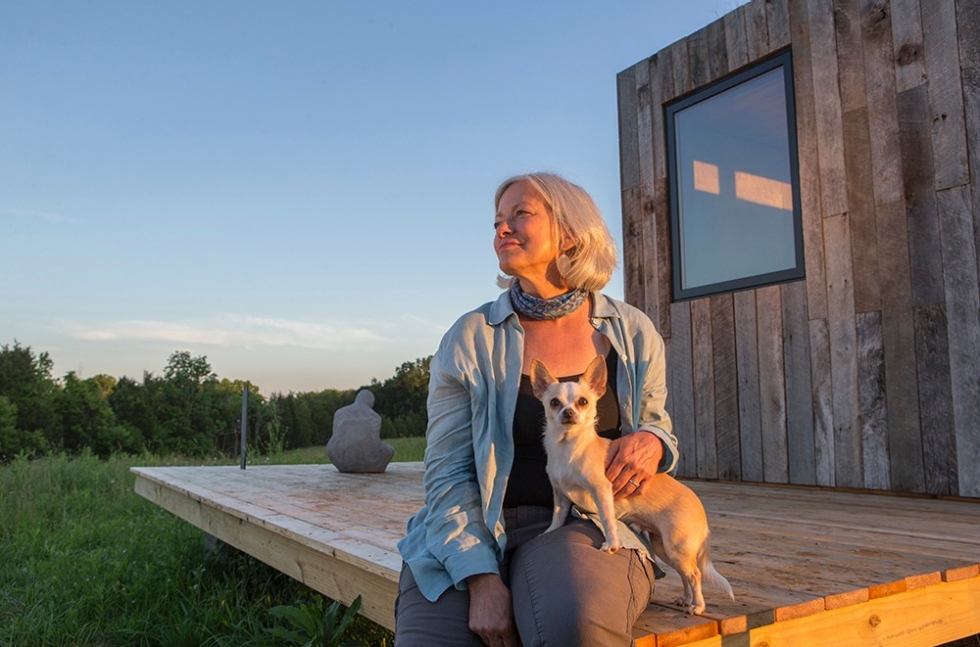Land steward Adrienne Cassel looks out onto Kamama Prairie in Adams County, Ohio, where she lives in a tiny house constructed by University of Cincinnati architecture graduate students. Photos/Andrew Higley/Creative Services
Tiny house on the prairie
UC connections help make a steward’s dream dwelling in an Ohio nature preserve a reality
by Jac Kern
513-556-1825
photos by Andrew Higley,
UC Creative Services
July 7, 2016
Sprawling across 92 acres of Adams County, Ohio, the Kamama Prairie nature preserve is home to hundreds of unique and rare plants, 72 types of butterflies and moths, a family of vultures and one “tiny house” created by University of Cincinnati architecture graduate students.
Thanks to the construction of this sustainable structure, the prairie is also now home to Adrienne Cassel, who has served as land steward for Kamama since 2013. As a lifetime volunteer, Cassel watches over and maintains the land, learns about its native plant and animal species and welcomes visitors to the site.
Kamama Prairie is part of Arc of Appalachia, a nonprofit organization that preserves and manages forests and other green spaces, including nearby ancient Native American effigy Serpent Mound. As a member of the Arc, Cassel learned about the stewardship position just as she was seeking volunteer opportunities to spend her time when she’s not teaching as a professor of English at Sinclair Community College.
“I wanted to do some volunteer work with nature because I am such a nature lover,” Cassel says. “I came to understand how threatened the environment is, so I wanted to balance my life in that way.”
She first visited the prairie in the spring of 2011. Kamama seemed like a perfect match for Cassel since it’s isolated from the Arc’s other connected preserves.
“I like a lot of solitude and quiet and I don’t mind being by myself,” Cassel says, “which is kind of unusual for most people.” And Kamama is quite unusual, too: The alkaline short-grass or cedar barren prairie is something of an anomaly for the region. The combination of uncommon soil conditions, an ever-changing ecosystem and its unique native plants have made Kamama a hotbed of rare plant and animal species. Simply put, there aren’t many prairies like this one in existence today.
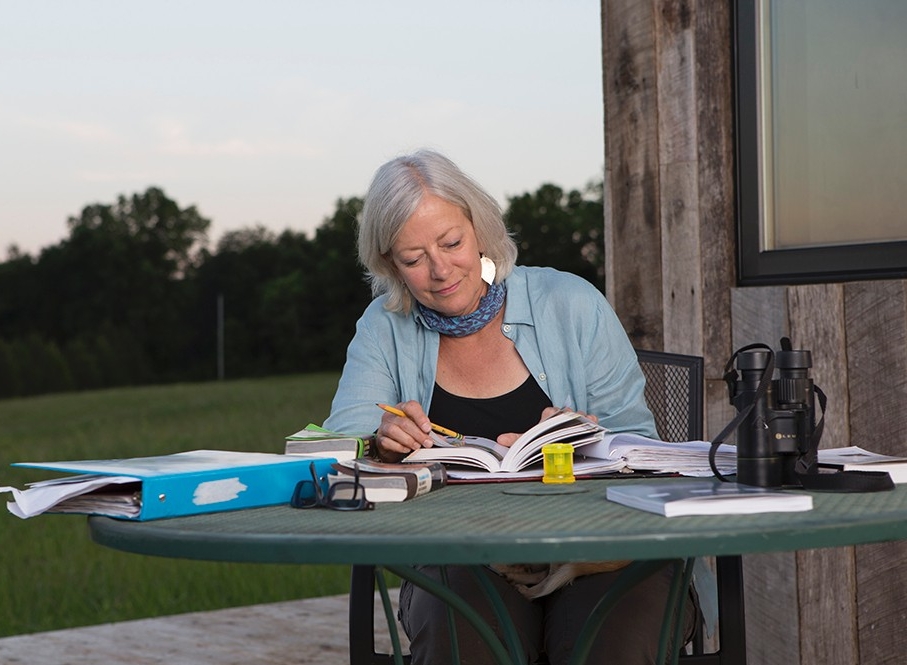
Cassel spends her time off site as a professor at Sinclair Community College. Photo/Andrew Higley/Creative Services
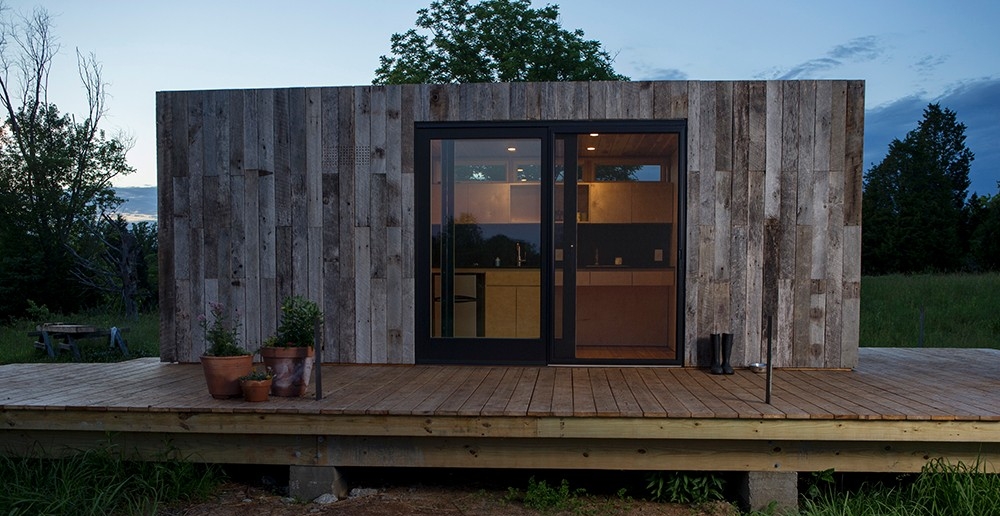
The tiny house has all necessary accoutrements — heating and cooling, a washer, kitchen and bathroom with electric and running water — all within 160 square feet. Photo/Andrew Higley/Creative Services

Land stewardship is an ideal form of service for Cassel, a lifelong nature lover. Photo/Andrew Higley/Creative Services
Cassel and an Arc manager hiked around the prairie and discussed the stewardship. On that hike, the two located some rare plants and both saw it as a sign. Cassel officially began her stewardship in 2013 and will continue as long as she’s able.
Before Cassel moved into her student-constructed house this summer, her stays on the land were spent sleeping in a tent. The only structures on site remained from the prairie’s earlier days as a farm and were either not livable or protected as animal habitats — indeed, Cassel does share the space with a family of vultures and plenty more wild creatures.
That’s part of the charm of land stewardship: being one with nature. Located near Peebles, Ohio, Kamama is free from pesticides and chemical treatments, secluded from the sound and smog of surrounding cities. Various bird songs replace the wail of sirens; neon signage gives way to a night sky lit up by stars and fireflies. (Cassel recalls a night when she was actually woken up by the glow of numerous fireflies beaming against the pitch-black prairie.)

Photo/provided
But having no secure dwelling also presented a number of issues: Exposure to the elements and insects like ticks, as well as a lack of water — for drinking and showering — created the need to make more frequent trips between the prairie and her home in Dayton, Ohio, a two-hour drive. She needed something more permanent on Kamama, with running water.
Cassel began to read up on small, sustainable houses. She envisioned a space that would leave a minimal impact on the surrounding prairie, both environmentally and visually — something that could eventually be solar-powered, with a composting toilet, barrels to collect rainwater for a shower and a maintenance-free exterior that could be secured when she left the site. Originally she reached out to construction companies in Adams County to build her house, but she found they could only offer more traditional methods and materials.
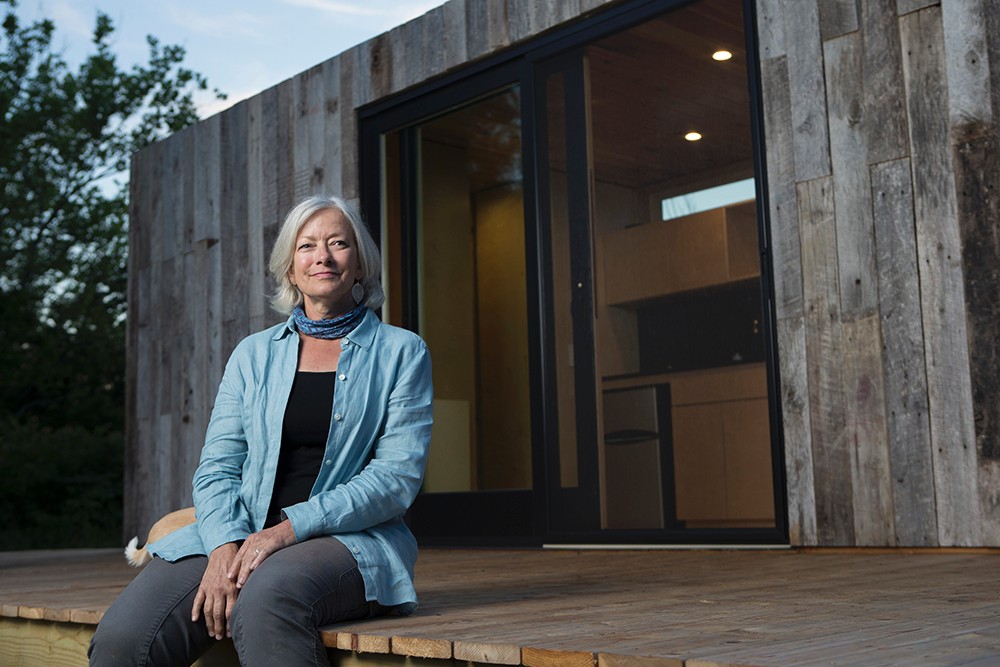
Photo/Andrew Higley/Creative Services
It was her connections to UC that helped Cassel, herself a doctoral graduate (A&S ’11), land a tiny house on the prairie that both fits all her needs and leaves as little impact as possible on the environment. Fellow Sinclair professor Diana Leakas, M (DAAP) ’08, suggested Cassel reach out to Michael Zaretsky, associate professor in UC's College of Design, Architecture, Art, and Planning's School of Architecture and Interior Design (SAID) and director of MetroLAB, a program within SAID that aids in innovative projects that support the infrastructure and development of a built environment. Cassel was already familiar with him — his wife Adrian Parr agreed to serve on her doctoral committee when Cassel decided to focus on eco-poetry. During the 2014-15 school year, Zaretsky was working with a grad student interested in tiny houses.
“I was thrilled to have someone who was finally on the same page about doing the eco design and construction,” Cassel says. Katie Schenk, M (DAAP) ’15, created original designs based on Cassel’s plans, but nothing was constructed.
That summer, DAAP associate professor Michael McInturf picked up the project for a design-build class. The group of 15 students came up with different designs, started soliciting donations (including a shipping container that laid the framework for the house), tore down some structures on site and salvaged what they could reuse.
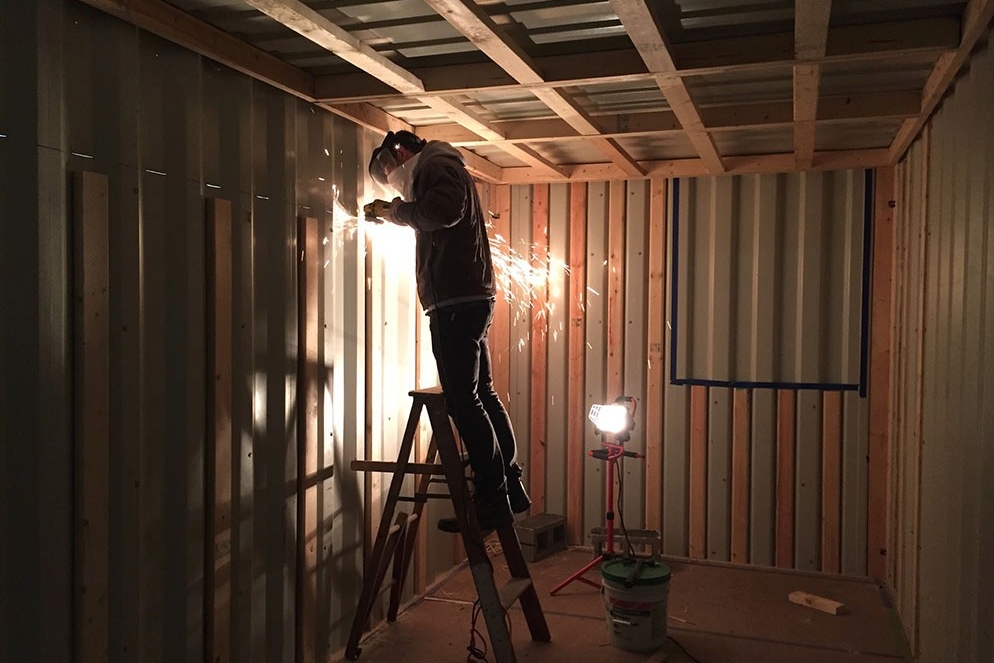

During most of the spring 2016 semester, students constructed the house inside a workspace near campus. Photos/provided
McInturf then became interim director of the department, and the project went on hold that fall. He approached DAAP adjunct assistant professor Whitney Hamaker, DAAP ’06, M (DAAP) ’08, to take over for spring 2016. It was Hamaker’s first graduate studio as a professor. He was joined by nine grad students he describes as being highly motivated — two of which came from the summer 2015 studio — who set a lofty goal of constructing the shelter and delivering a finished product in one semester.
“It’s an insane time commitment to do something like this in the short amount of time that we had to do it,” says student Marissa Zane, DAAP ’13, who returned to the project that spring after taking the summer studio.
The group went back to the drawing board, spending five weeks on redesign. That left just 10 weeks in the semester for actual building. Between the 75-mile drive to the preserve and the fact that Ohio’s winter weather typically carries on into March and April, it was not feasible to construct solely on site. Hamaker secured a space near campus to store and work on the container, and the students completed much of the framing, construction, plumbing and electric work there over the next eight weeks.

The students' craftsmanship extends inside the tiny house with beautiful woodwork. Photo/provided
Finally, with the end of semester on the horizon, the group traveled out to Kamama, following the tiny house as it made its way on a flatbed truck. Seeing the house moved out to the site was a major moment for them.
“It kind of hits you that you actually built something that’s going to be there for years to come, and it fits within the nice peacefulness of the prairie,” says student Alex Gormley, DAAP ’13. “It’s kind of a poetic moment.”
After the class worked a few weeks into the summer making finishing touches, Cassel “moved in” this past June. She maintains a home in Dayton, but is able to make extended stays on the prairie now. Hamaker hopes students in a fall seminar will be able to complete an additional roof structure with integrated solar that was designed, which will shade the deck and house.
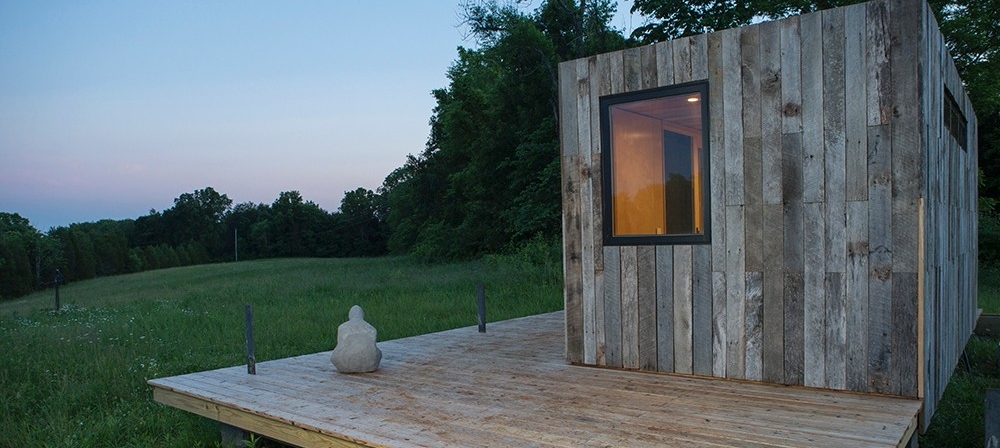
Photo/Andrew Higley/Creative Services
In Cassel’s case, a tiny house was perfectly suited to her needs, especially when it comes to having a low impact on its surroundings. “The prairie is what people go there for,” says Hamaker. “It’s a beautiful landscape already. We wanted what we built to fit with the landscape and, in a sense, be present but minimal, respect the landscape and have an understanding with the vernacular that existed there.” But tiny houses are something of a fad right now.
The movement is apparent in photos and how-tos all over Pinterest, TV shows like FYI’s Tiny House Nation and HGTV’s Tiny House Hunters and public projects like Brad Cooper’s (DAAP ’09) Start Small Homes project, which sets out to create tiny homes in Over-the-Rhine.
“It’s cool [tiny houses] are catching on and people are learning you don’t really need as much space as you think you need,” says student Dylan Holte, who also participated in the previous summer studio.
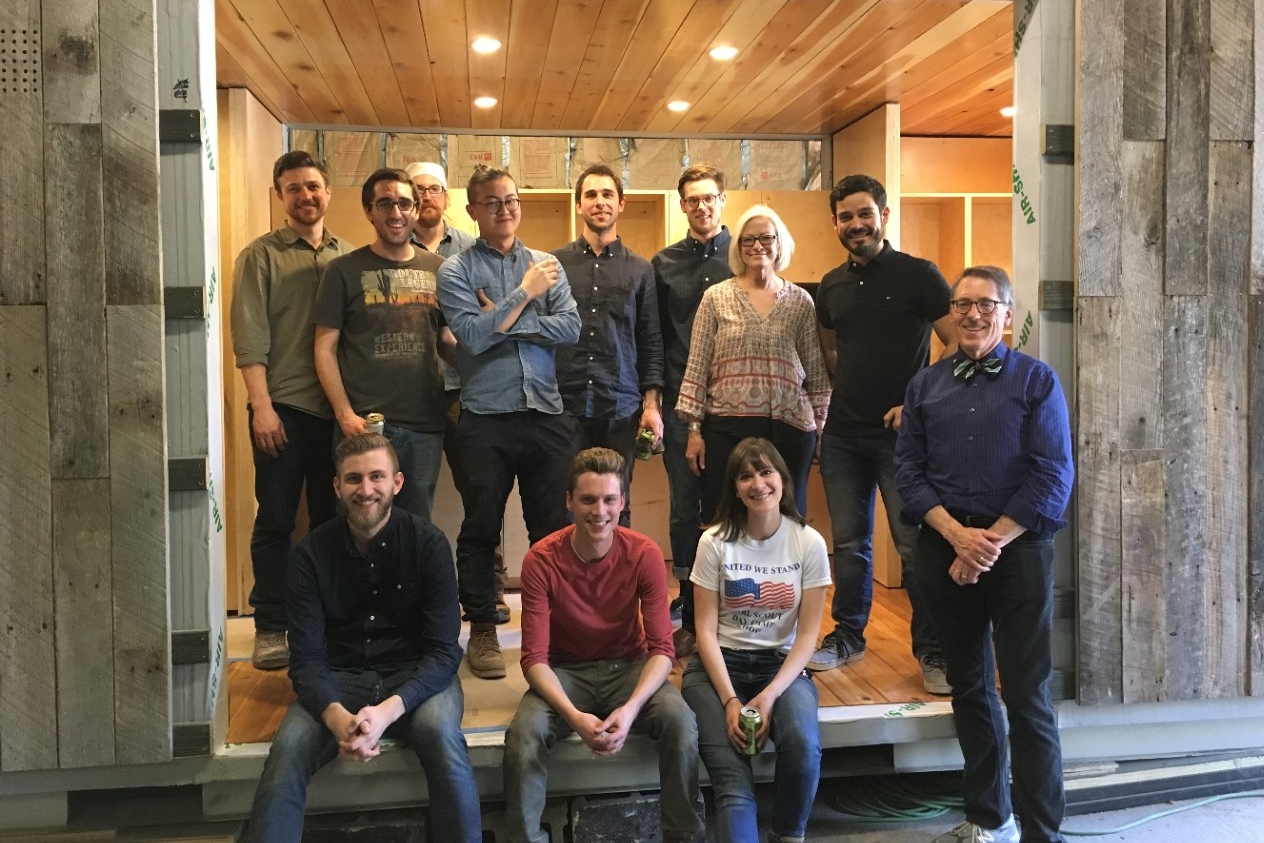
Students from the spring 2016 semester gather with Cassel and professors in the under-construction house. Left to right (front row): DAAP graduate students Jon Lund, Alex Gormley, Marissa Zane and structures professor Tom Bible. Left to right (back row): DAAP graduate students Tom Covert, Narek Mirzaei, studio professor Whitney Hamaker, Guande Wu, Alex Bucher, Dylan Holte, land steward Adrienne Cassel and Luis Sabater Musa. Photo/provided
Cassel’s idea for a tiny house came more out of necessity than following the mainstream architectural trend du jour. But make no mistake, it is tiny — at 160 square feet, the space is equipped with electricity, heating/cooling, a fully functioning bathroom with a shower, a washer, kitchen and bed. The house tour takes about 20 seconds. An elevated deck that surrounds the home provides ample gathering space outside. Patio furniture doubles as an office where Cassel can grade papers and plan lessons under the setting sun. She’d rather be outside in nature, anyway.
“The class understood that the focus is the prairie and preserving that land, and the way they designed the structure out there, there’s very little impact on the prairie,” Cassel says. “It’s not about the tiny house, it’s about how it blends in with the prairie — like the deck, it extends out into the field. That’s also something I love about it and something that’s important that they understood.” On contract to spend five months a year on site, Cassel will now be able to oversee Kamama year-round.
It’s fitting that the house was ready at the start of summer, when brown grass and bare trees give way to the prairie’s most colorful inhabitants. As she settles into her new home, dozens of butterflies will descend upon the area as the prairie lives up to its name — “kamama” is Cherokee for “butterfly.” In 2012, a previously unknown species of moth was discovered there.
It’s fitting that the house was ready at the start of summer, when brown grass and bare trees give way to the prairie’s most colorful inhabitants. As she settles into her new home, dozens of butterflies will descend upon the area as the prairie lives up to its name — “kamama” is Cherokee for “butterfly.” In 2012, a previously unknown species of moth was discovered there.
It’s fitting that the house was ready at the start of summer, when brown grass and bare trees give way to the prairie’s most colorful inhabitants. As she settles into her new home, dozens of butterflies will descend upon the area as the prairie lives up to its name — “kamama” is Cherokee for “butterfly.” In 2012, a previously unknown species of moth was discovered there.
It’s fitting that the house was ready at the start of summer, when brown grass and bare trees give way to the prairie’s most colorful inhabitants. As she settles into her new home, dozens of butterflies will descend upon the area as the prairie lives up to its name — “kamama” is Cherokee for “butterfly.” In 2012, a previously unknown species of moth was discovered there.
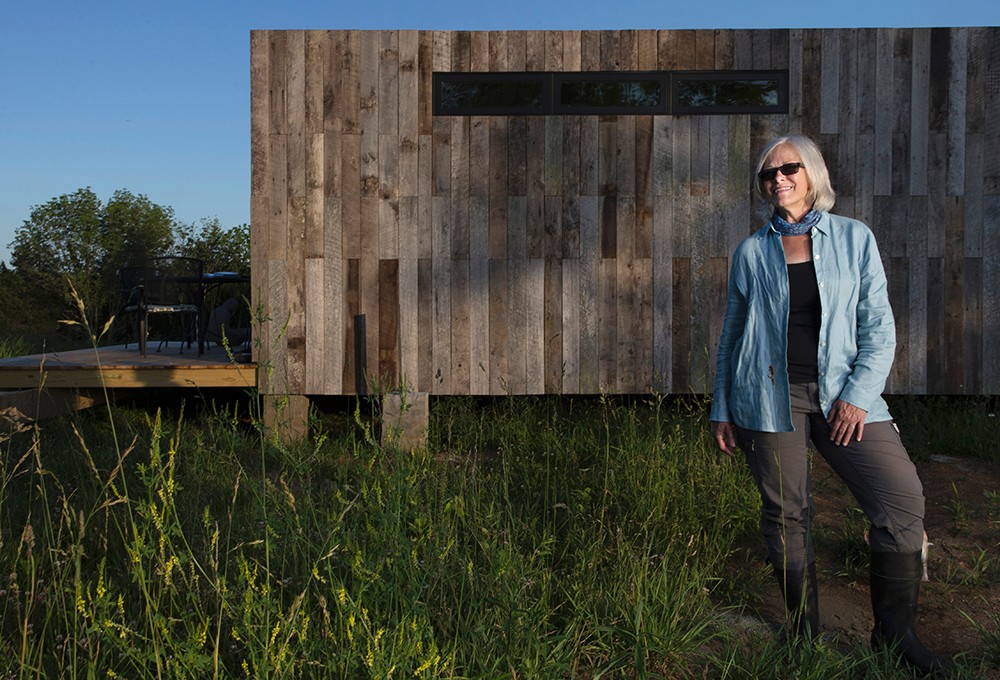
Photo/Andrew Higley/Creative Services
Cassel is responsible for the home’s expenses, which are offset by the donated materials and labor and a crowdfunding site set up through UC Research Institute. And even after her days as a land steward are over, the house will remain on site for her successor. She recognizes that her connections to UC helped make this project possible and, even after graduation, they continue to grow.
“It’s a really important relationship that goes on through life,” Cassel says.
Likewise, this studio experience will likely leave a lasting impression on the nine students who designed and constructed the major project in just four months.
“I don’t think the goal of a design-build program is to turn architecture students into contractors,” Hamaker says, “but I think it is important for them to understand that relationship — the difference between what we put out into the world and what has to happen to make it exist, and to understand what that conversation is.”
Zane is reaping the benefits of this already as she works on co-op in New York.
“I went out to a job site last week and I actually understood what they were doing,” she explains, “unlike if you’re at an office job and you see things here or there. It may take years for you to understand something that you learn in just a couple months by putting something together.”
LINKS:

